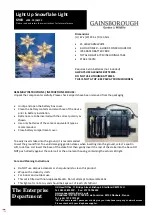
USER’S MANUAL. PE-455
11/2014
Page
7
En
g
lis
h
4. MEASURING METHODS
OPERATION CAUTION
Observe all safety precautions when the FUNCTION switch is set to 250 V, 500 V, 1000
V position. Connect the meter test leads to the circuit under test before operating the
TEST button. Do not touch the paper clip ends of the test leads while is carrying out a
measurement.
Some electrical equipment, especially cables, may retain an electrical change when
disconnected from the line. It is good practice to discharge such equipment with
grounding straps, or other suitable devices, before touching or making connections. The
meter automatically discharge the test circuits when a test is completed.
IMPORTANT
Remove all power to the circuit under test when making resistance measurement. If any
voltage is present in the test circuit, the indicator of external voltage (LIVE CIRCUIT)
LED located on the meter front plate will light. Immediately disconnect the test leads
and turn off power to test circuit.
•
Function Switch:
The FUNCTION switch is used to select the range, or function desired.
•
Test button:
The TEST button is normally OFF, press to start and to stop the test. When
beginning the test, automatically will activate a timer from 3 to 5 minutes that will
stop the measurement whenever the TEST button in not again pressed.
•
Always check the following before testing:
The message " Low Battery " does not appear on the LCD screen.
There is no visual damage to the instrument or test leads.
•
Test Lead Continuity
Select the CONTINUITY function and
Ω
range. Short the test leads together.
An over-range ("1") indication mean the leads are faulty or instrument fuse is blown.
(See "Fuse Replacement" section).
•
Insulation Resistance Testing
WARNING
: Insulation tests should be conducted on circuits that are de-energised.
Ensure circuits are not live before commencing testing.
−
Select the required test voltage (250 V, 500 V or 1000 V) by rotating the
FUNCTION switch.
−
Connect the test leads to the instrument and to the circuit to be tested. (See
connect diagram). If the "LIVE CIRCUIT" is light, do not press the TEST button
and disconnect the instrument from the circuit. The circuit is LIVE and should be
de-energised before further testing.
Summary of Contents for PE-455
Page 4: ...USER S MANUAL PE 455 ...
Page 10: ...USER S MANUAL PE 455 Page 6 11 2014 ...
Page 15: ...PROMAX ELECTRONICA S L ...

































